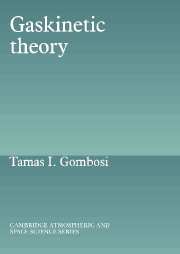6 - Generalized transport equations
Published online by Cambridge University Press: 16 September 2009
Summary
In its most general form the Boltzmann equation is a seven dimensional non-linear integro-differential equation (see equation (5.29) or (5.30)). The solutions of the Boltzmann equation provide a full description of the phase space distribution function at all times. In most cases, however, it is next to impossible to solve the full Boltzmann equation and one has to resort to various approximate methods to describe the spatial and temporal evolution of macroscopic quantities characterizing the gas. One successful way to find approximate solutions is the Chapman–Enskog method discussed in the previous Chapter. This method uses a power series expansion around the equilibrium distribution function (Maxwellian) to describe slightly non-equilibrium gases. The method assumes that coefficients of increasing powers of random velocity components are proportional to increasing powers of a smallness parameter, thus ensuring rapid convergence.
An alternative, and mathematically equivalent, method was developed by Grad in the late 1940s. In this method transport equations for macroscopic molecular averages are obtained by taking velocity moments of the Boltzmann equation. This seemingly straightforward technique runs into considerable difficulties because the governing equations for the components of the n-th velocity moment also depend on components of the (n+1)-th moment. In order to get a closed transport equation system one has to use closing relations (expressing a higher order velocity moment of the distribution function in terms of the components of lower moments) and thus make implicit assumptions about the distribution function.
- Type
- Chapter
- Information
- Gaskinetic Theory , pp. 187 - 226Publisher: Cambridge University PressPrint publication year: 1994

